The Fugio Cent Thread
 Rittenhouse
Posts: 618 ✭✭✭✭
Rittenhouse
Posts: 618 ✭✭✭✭
I am one of those poor unfortunate souls who have become Fugio cent fanatics. A friend got me interested in the history of these pieces. One day while I was slogging thru the Journals of the Continental Congress and I found the authorizing legislation, which conclusively showed that these pieces were not only federally authorized, they were also authorized as cents and were to be struck at the federally mandated weight for that denomination.
Discovery of the legislation completely overturned the then current view of these pieces as some minor, privately-struck token coinage with no established value. John Dannreuther and I quickly came up with an article, approached other interested researchers about "signing-on" and offered the article to PCGS since John is one of the founding members and they have been very supportive our research for quite some time.
PCGS published the article as a new release on Feb. 1, 2022: https://www.pcgs.com/news/fugio-cents-the-first-regular-issue-united-states-coin. Concurrent with the news release, PCGS recategorized Fugio cents as "Federal Contract Coinage" (they also allowed them to remain in the Colonial Coin category to not disrupt the Registry sets).
The effect was immediate and quite stunning. Dannreuther and I expected somewhere around a 30% pop in price. However, within two months, the price for common variety pieces in VF to AU55 had doubled at auction and the super common pieces in MS63 to 64 were up about 40%. Today you're lucky to see more than two Fugio cents at any show and those will likely be corroded. JD and I joke that we "shot ourselves in the wallet."
So, that's the background, now for some fun facts and info:
Fugios are not only the first federal coin, they are the first large cent and, with an estimated mintage of 398,577, they are the seventh-rarest large cent by mintage, slightly ahead of the 1796 Draped Bust cent mintage of 363,375. Most Fugios are scarce to rare, so forming a collection is quite a challenge. There are as many R5 and R6 varieties as there are R2 and R3. There are six R7 and ten R8 varieties, including the one recently discovered. Excepting the uncirculated Bank of New York Hoard varieties (Newman 8-B, 8-X, 9-P, 11-A, 11-B, 11 X, 12-X, and 13-X), Fugios are typically seen in Good to Very Fine, often “details graded” due to corrosion. This does not mean they are unattractive or undesirable; serious collectors buy they best they can find and afford for the variety, even if that is a details-graded VG.
Advanced variety set collectors try for as many varieties as possible with fifty or more being a major milestone. Be prepared to spend $80K or more if you choose to assemble an advanced variety set. A more affordable approach is to start with a Basic Design-Type set and then go on to the Advanced Design-Type set.
Note that I do not include the American Congress Reverse in either Design-Type set. Records show that the Board of Treasury rejected the reverse design for regular issues making this variety a pattern piece, and a rejected one at that.
Basic Design-Type Set
1 Over Horizontal 1 Obverse (Newman Varieties 10-G, 10-00, 10-T. 10-T and 10-G are R5, 10-OO is R-8)
Club Rays “FUGIO” Obverse (3-D and 4-E, both are R3’s. Easily obtained in VF to AU)
Concave Rays Obverse (2-C is the most “common” and is still $3K for a G. VF Details brings $5 - 7K)
Cross After Date Obverse (1-B, 1-L, 1-Z, 1-B is the most common. 1-CC is a pattern)
Eight-Pointed Stars Reverse (one variety, 15-Y. Fortunately it’s an R-2)
Four Cinquefoils Obverse (Most obverses are four cinquefoils. 8-B, 8-X, 12-X, and 13-X are very common)
Raised Rims Reverse (1-Z, 12-Z, 19-Z. 12-Z and 19-Z are the most common at R-5)
States United Reverse (most reverses, 12-M, 12-X, 13-X, and 16-N are common)
United States Reverse (several reverses, 1-B, 8-B, 3-D, 4-E, 15-H, 21-I are common)
Advanced Design-Type Set
This is where it starts getting expensive. The advanced set includes all of the coins in the Basic Design-Type set, plus the variations such as the 1 Over Horizontal1 with both the UNITED Left and STATES Left reverses. It also includes the unique reverse with UNITED at the top instead of left or right (11-A). While 11-A is a Bank of New York Hoard coin, there are only about 25 pieces, most are uncirculated and start around $15K.
1 Over Horizontal 1 (both STATES Left and UNITED Left reverses)
Concave Rays “FUGIO” Obverse (5-F is the only “affordable” one and a VG Details will still set you back around $10K)
Cross After Date Obverse, all three reverse types (1-B, 1-L, 1-Z)
UNITED Above Reverse (11-A)
Now for some coin porn. Here's my unc 11-A, most incredible luster I've ever seen.
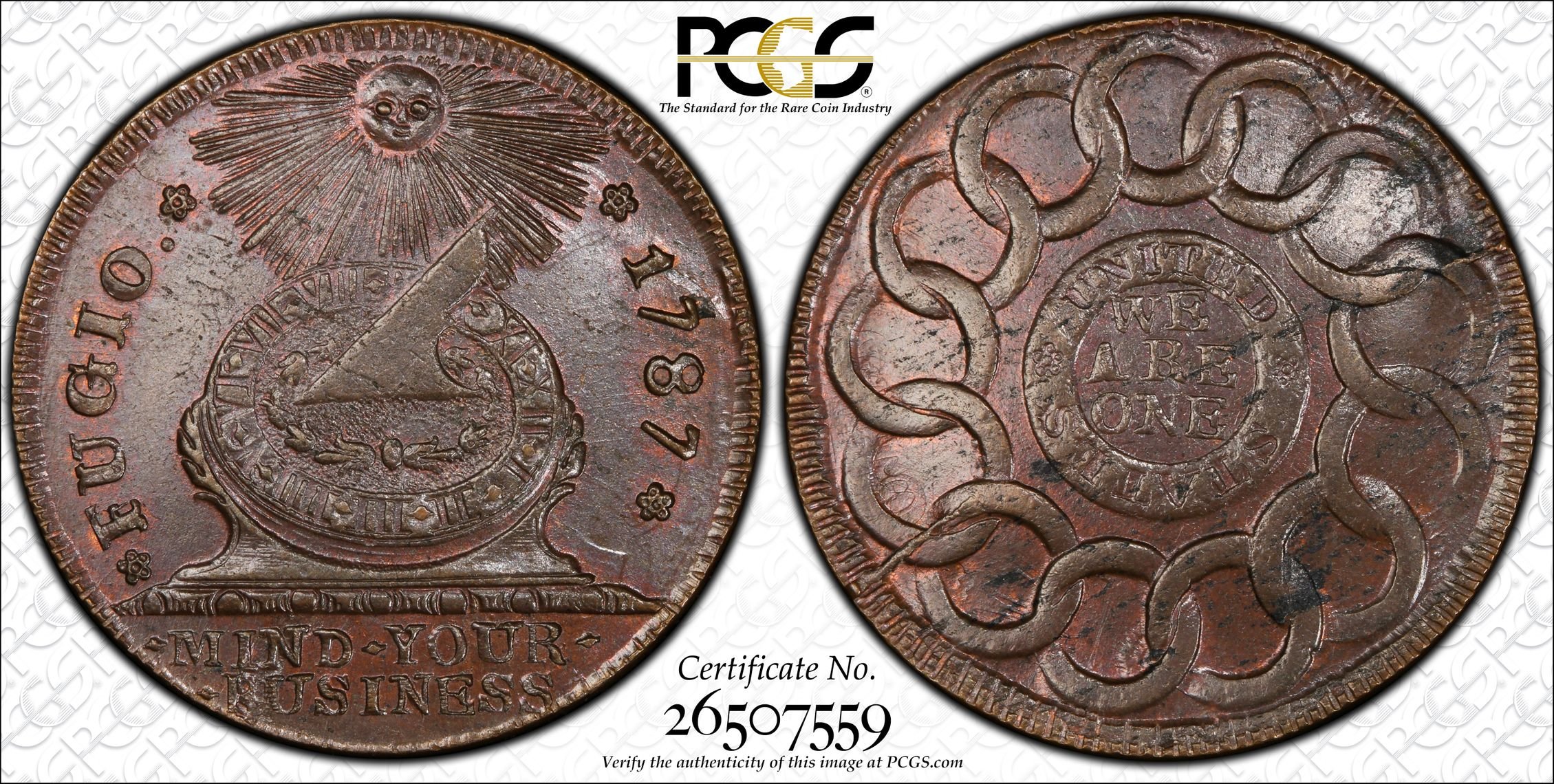
And the Betts fantasy piece 101-EE, Bushnell/Norweb, finest known: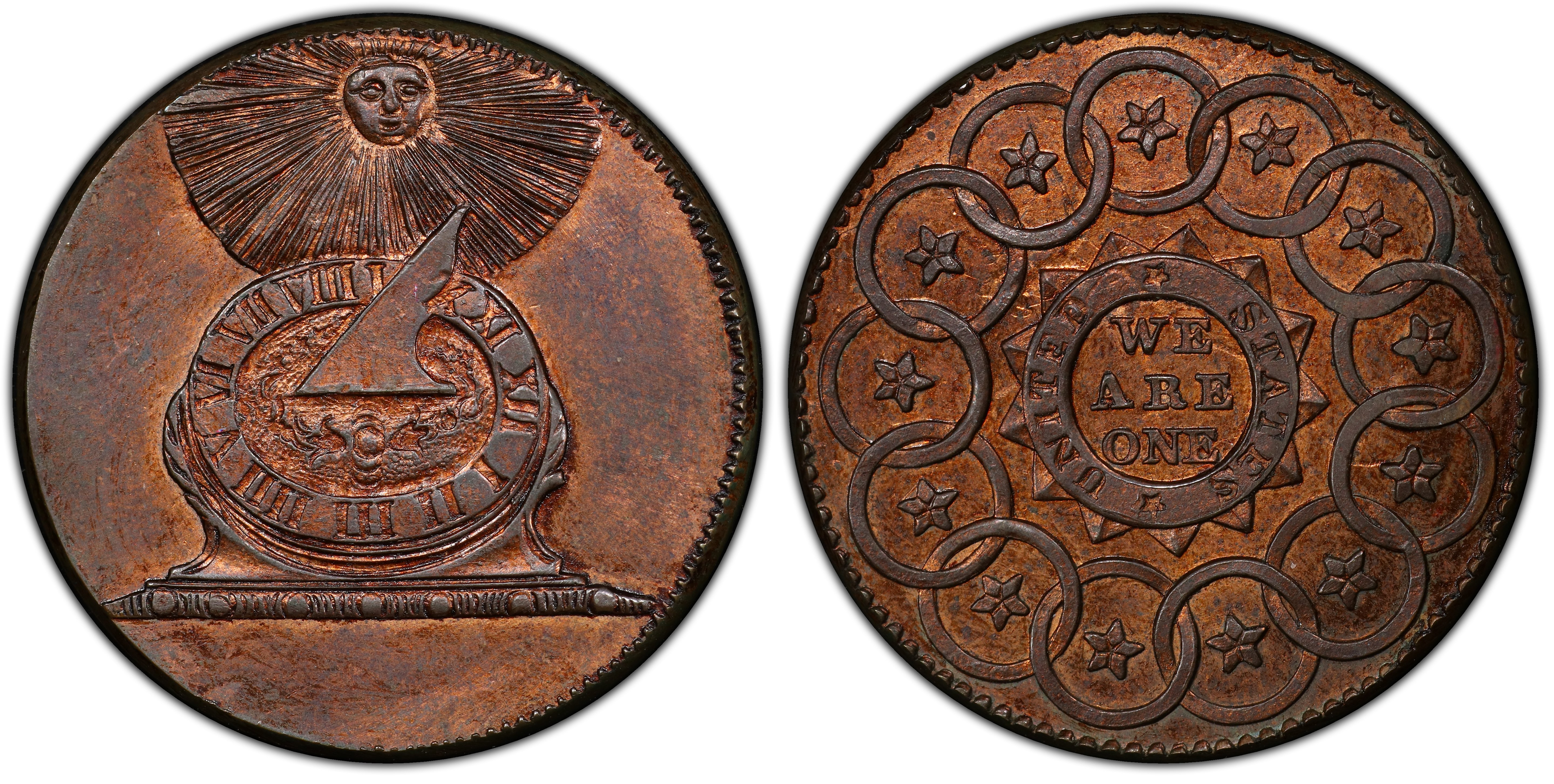
I'll post more fun facts and info later. Please feel free to post your own favorite Fugios.
Comments
Those are stunning!
Click on this link to see my ebay listings.
Now THIS thread is worth following. I may have to add more Fugios to my expanded type set. Thank you for posting!
Here's one of mine, albeit poorly photographed:
On the web: http://www.earlyus.com
Excellent read--thanks. Jarvis was certainly a character.......
Condition precedent to the contract was that coinage pass inspection by a " officer appointed by and paid by the United States." I could not find a record regarding same. Do you now if a officer was appointed by the Confederation Congress and accepted any of the coins?
It appears that may be unlikely, although not impossible, given the Committee Report of September 16, 1788 :
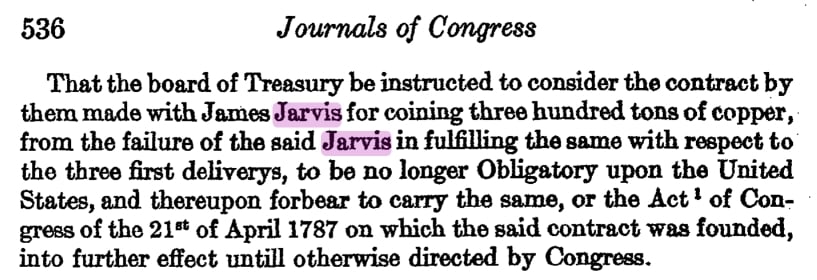
Sorry to bringing this thread down so many grades so fast. The posts will go back up from here I'm sure. 😉
Disclaimer: I'm not a dealer, trader, grader, investor or professional numismatist. I'm just a hobbyist. (To protect me but mostly you! 🤣 )
Cool thread! I've never owned one but look forward to seeing who has them.
Great post! I have long considered the Fugio Cent to be the KEY coin in any collection of U.S. coins which is focused on history. To me, it signifies the very declaration of our union to the world with the words on the reverse "United States - We Are One". It is only appropriate that it now has ascended after two centuries to its proper place and I congratulate Rittenhouse and all who have worked to achieve this.
Here is my example, which I love. I don't care that it is plugged and is a so-called "details" coin. It is pure history to me. I look at it often and think about it and the associated history even more regularly. If you don't own one, I encourage you to acquire the best example you can reasonably afford.
I love Fugios and bought several over the years before the prices shot up. Unfortunately, no high grade ones! here are a couple
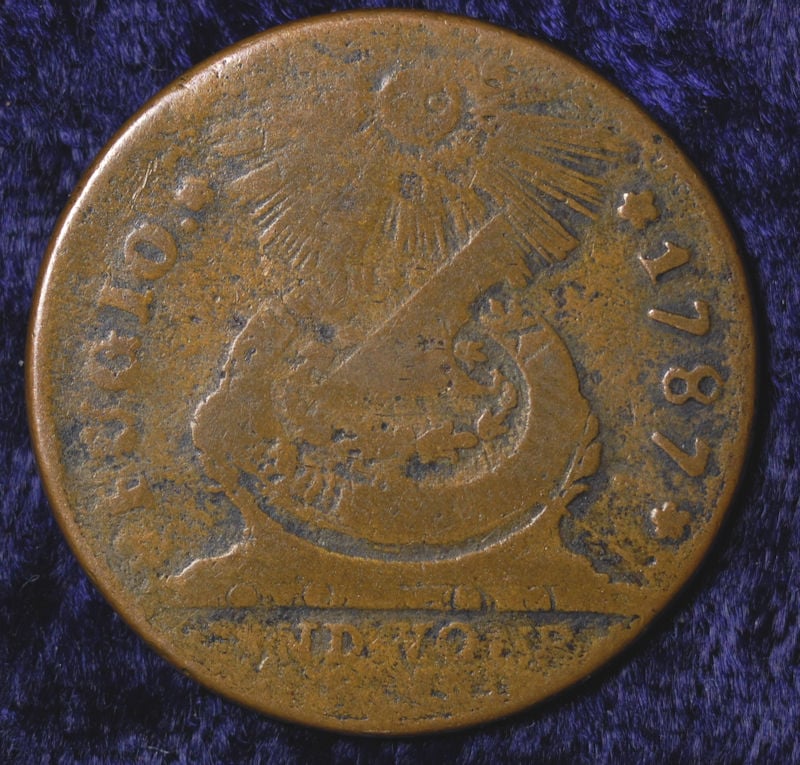
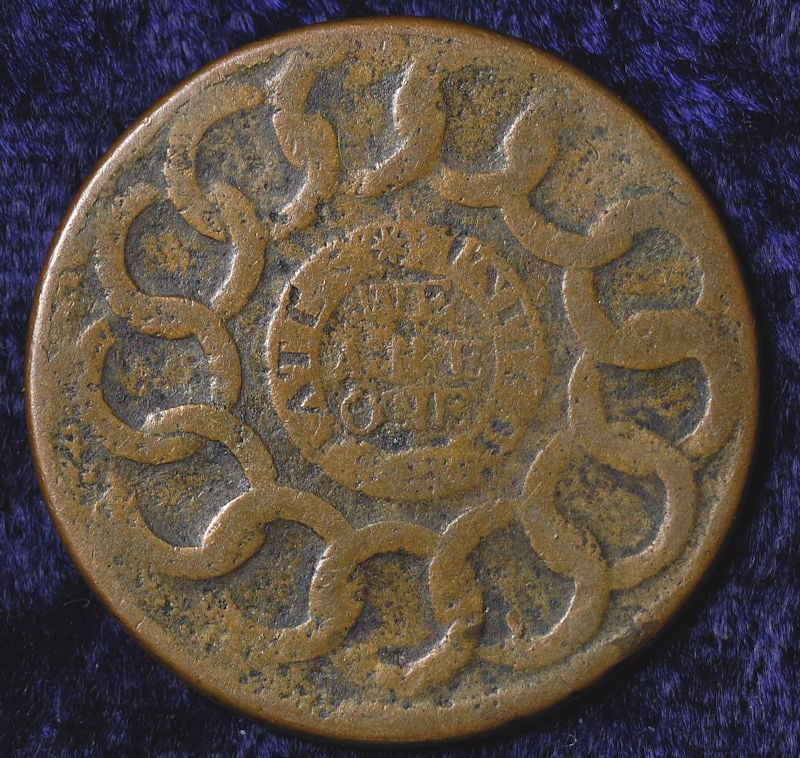

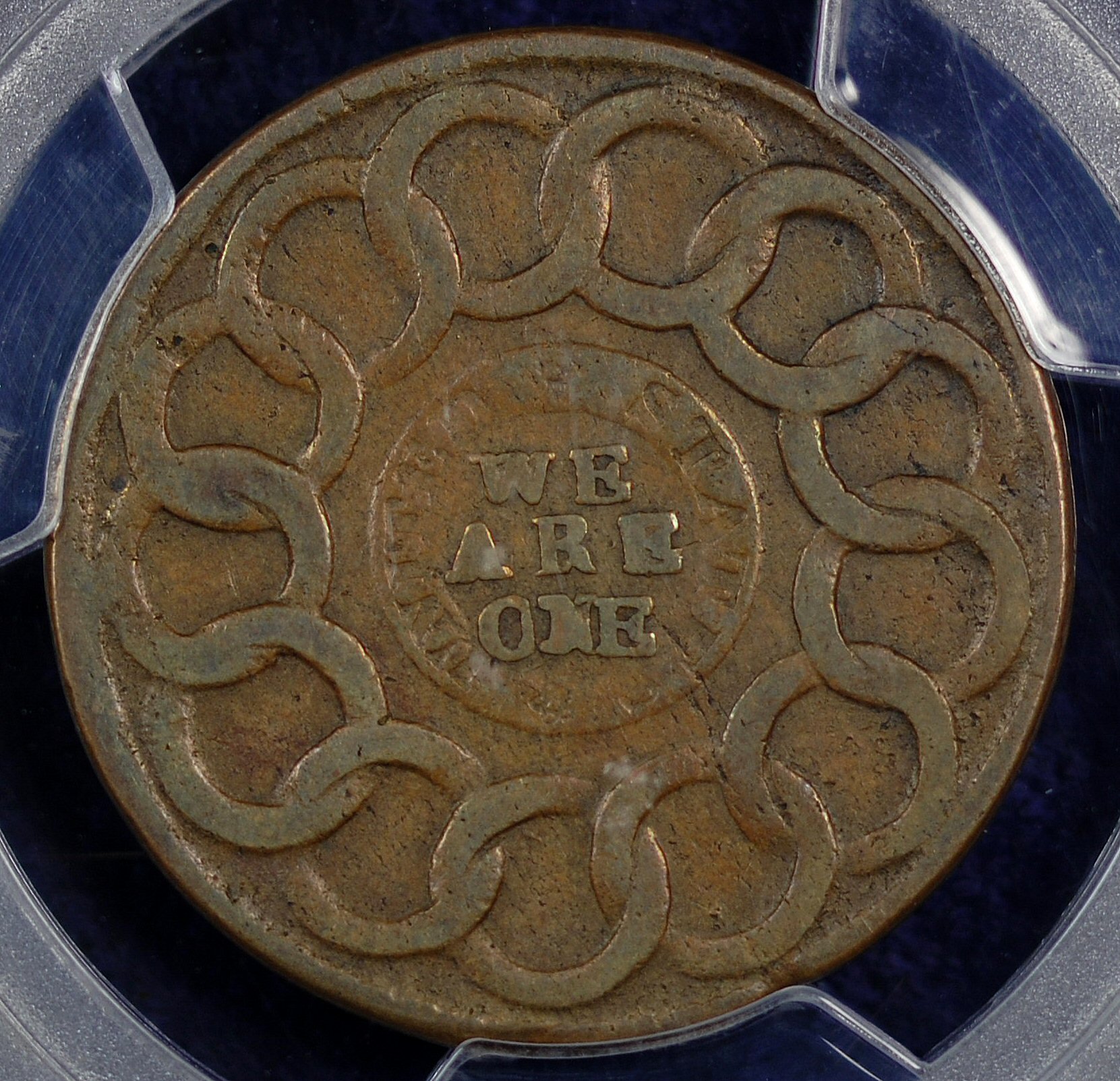
Cool thread... I'm looking to include one in my Box of 20.
Successful BST transactions with: SilverEagles92; Ahrensdad; Smitty; GregHansen; Lablade; Mercury10c; copperflopper; whatsup; KISHU1; scrapman1077, crispy, canadanz, smallchange, robkool, Mission16, ranshdow, ibzman350, Fallguy, Collectorcoins, SurfinxHI, jwitten, Walkerguy21D, dsessom.
I love Fugios too!
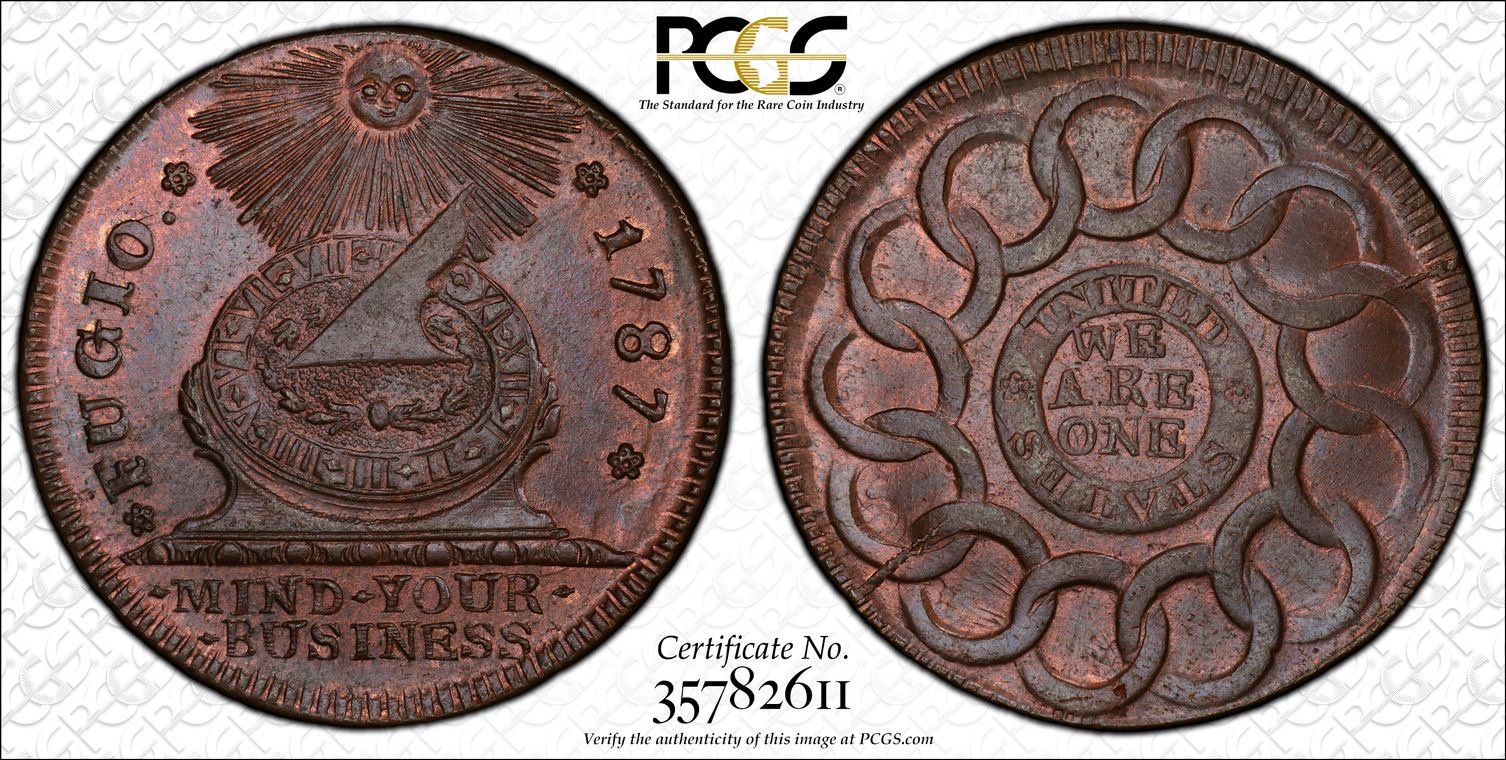
Here’s my 66RB
@Rittenhouse
That's a stunning Fugio.
I have a Newman 1-L that's from the Norweb Collection and x-Richard Picker. Unfortunately I don't have a photo readily available.
I have always liked Fugios, especially the Ben Franklin motto Mind Your Business.
Pacific Northwest Numismatic Association
Now here is a thread worth bookmarking!
TD
Thanks for starting this discussion. I posted the following thread after making my only Fugio Cent acquisition almost 2 years ago. I received very good advice but have not taken any action since. Perhaps someone will have some additional input on my questions concerning conversion to a PCGS holder.
I bought the Fugio because I was working on a high grade Large Cent type set and thought it would be cool to add this to the set.
https://forums.collectors.com/discussion/1095550/advice-on-a-new-fugio-cent-acquisition#latest
For those not familiar with the grade rarities of Fugios, FF just posted the finest known 11-A. With about 25 known, 11-A is rare in any grade, but a 66 with amazing luster is truly a unicorn. Good show FF.
BTW, 11-A is a "Bank of New York Hoard" coin and most of them are high grade unc, although there a couple nice AUs. I also own one very nice AU50 that PCGS must have been in a really bad mood when they graded.
The BNY Hoard story is quite interesting., In 1856, an entire keg of Fugios was discovered in the basement of BNY. Since Royal Flint borrowed money to buy all of the Fugio cents from the US Board of Treasury in hopes of retailing them and subsequently went bankrupt still owing 2/3 of the loan, it is presumed by many Fugio researchers that these are the pieces that were retained by the bank as collateral. Talk about history...
Over the next 100 years, the bank gave out pieces to valued employees ad customers. In 1948, Damon Douglas examined the remaining 1641 coins and collated the results in his unfortunately unpublished manuscript. Fortunately, the ANS has made the Douglas Manuscript available at: https://archive.org/details/DouglasJarvisMS. I strongly suggest those with a serious interest in the Fugios read Douglas' work.
Yes, according to Jarvis' account book (published in The Colonial Newsletter, April 2017), Mr. John Blagge of NYC was the receiving agent.
And you're right, Jarvis was quite a character. He's one of the four worst scoundrels in US minting history, the others being Franklin Peale, Henry Linderman, and A. Loudon Snowden, I'll post on this later.
Anyway, in addition to the contract for 300 tons of cents, Jarvis also accepted 25 tons of scrap copper from the US gov't which he was to convert to cents, delivering about half as as coins and keeping the remaining amount as his payment.
Jarvis never met the delivery schedule on either contract. In fact, the US Comptroller's report show he delivered just 8968 lbs. of cents (see Damon Douglas' manuscript). Jarvis fled NY (the seat of govt at the time) for NJ to avoid prosecution. Subsequently, he left a trail of failed contracts and broken mortgages. He was, in short, a flim-flam man.
The problem with Jarvis is that he was as financially stupid as he was greedy. He took the govt copper noted above and converted it into Connecticut coppers (valued at a halfpenny) since they were lighter in weight and thus produced a greater profit. He figured he could replace the copper at a later date with no one the wiser. It was a bait-and-switch of a sort. It didn't work because he could not replace the copper - the US had no major sources, copper was mostly imported from England and the terms were cash on delivery.
As to the main contract for 300 tons of cents, Jarvis made a very serious error. As payment, he was to receive 20 year interest only 5% US bonds. Unwilling to put his own money at risk, he tried to borrow copper (or money to buy copper) on the bonds he had yet to receive because payment was only on delivery. He got laughed at all over the US and Europe. Not only was there a question as to the US gov't being able to pay (we owed millions in war debt), but "solid as gold" English Consolidated Debt bonds yielded around 4.5% at the time.
What a dumbass, he took a contract to strike tons and tons of copper coins when he had no copper, was unwilling to buy it with his own money, and he was the one who came up with the bond terms, from a bankrupt nation! Stupid is as stupid does, and Jarivs took the cake.
Even more stupid is the fact that if he had delivered the first 75 tons or so on schedule, he could have held the US for ransom and got paid for cancelling the contract. Shortly after Jarvis accepted the contract, the value of copper coins began to sink rapidly due to oversupply. In a really dumbass move, state authorities allowed the importation of millions upon millions of lightweight coppers from England. The market became flooded and the value of copper coins collapsed.
If Jarvis had made the first few deliveries, he could then have offered to let the gov't to buy out the remaining contract rather than continue to accept delivery and pay for coins rapidly declining in value. He'd have made more that way than is actually delivering on the contract!
For those who care to read more, I've attached an article I published in PW.
Great reads! Thanks @Rittenhouse for the link and download.
Wow! @Rittenhouse has really created an exceptional thread with lots of great info. I would like to echo previous comments and say "THANK YOU" for sharing this information here.
The Fugio is a unique and tangible connection to our very origin as a republic and its story is truly fascinating. Also, thanks to everyone who has shared their images here. No matter the condition, they are ALL amazing & historic pieces.
This is all I can add to this thread. Also a great thank you for the info provided!
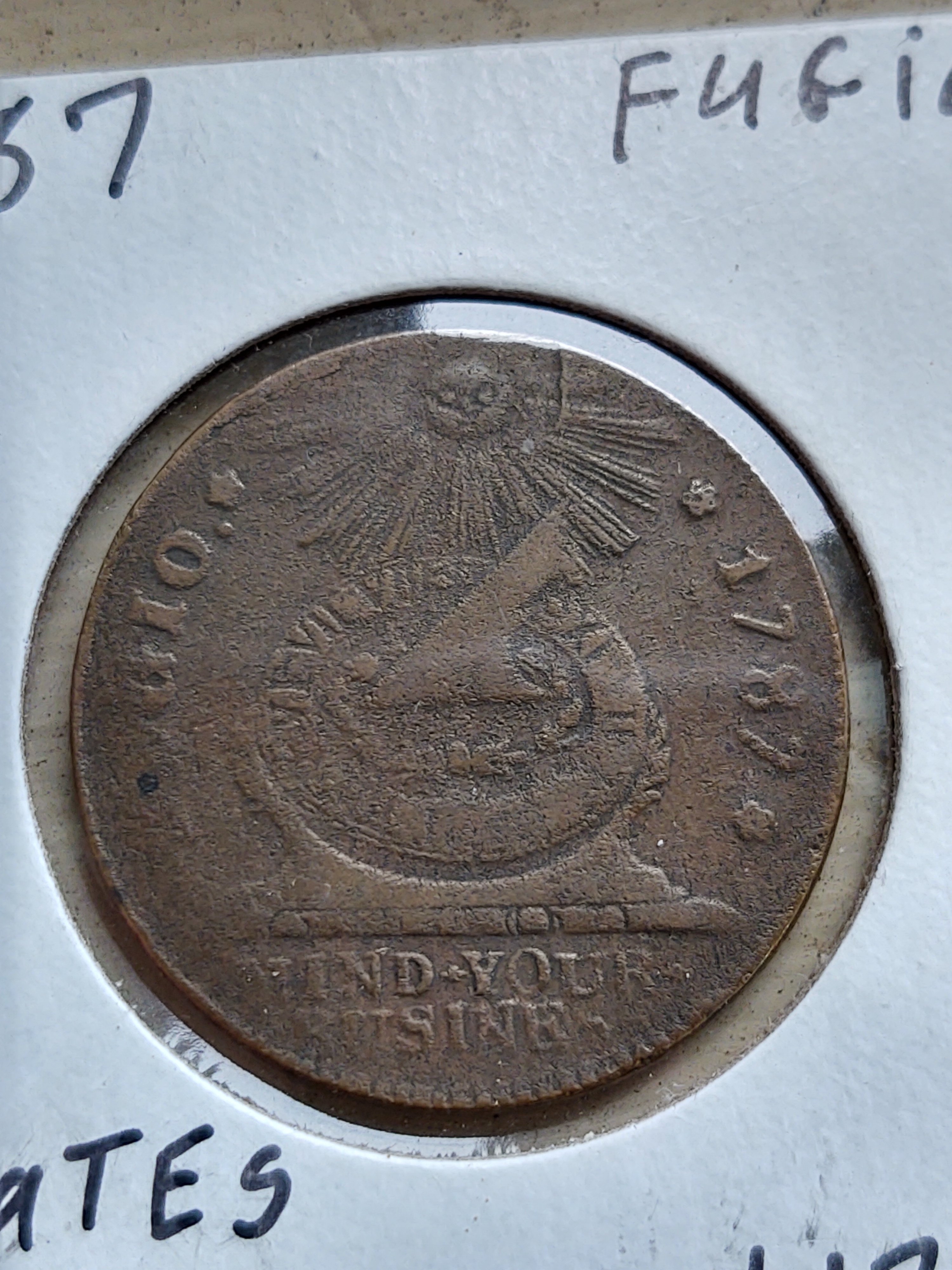
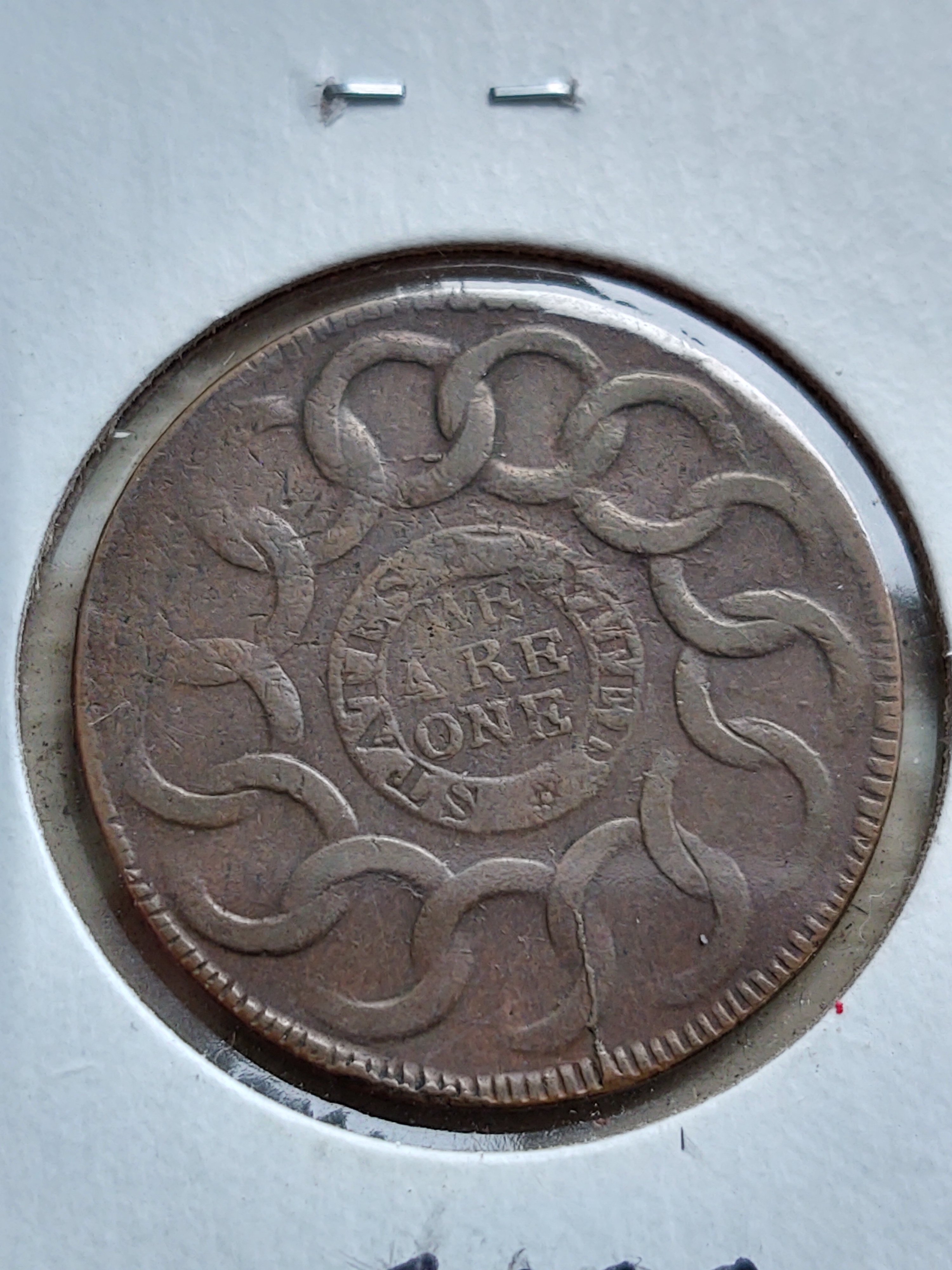
Tonedeaf is a nickname given to me in reference to my guitar playing ability.
GREAT thread! Here are the two in my collection:
I darest not linger long here…
Smitten with DBLCs.
Some nice coins in this thread!
Empty Nest Collection
Favorite "Fugio:"
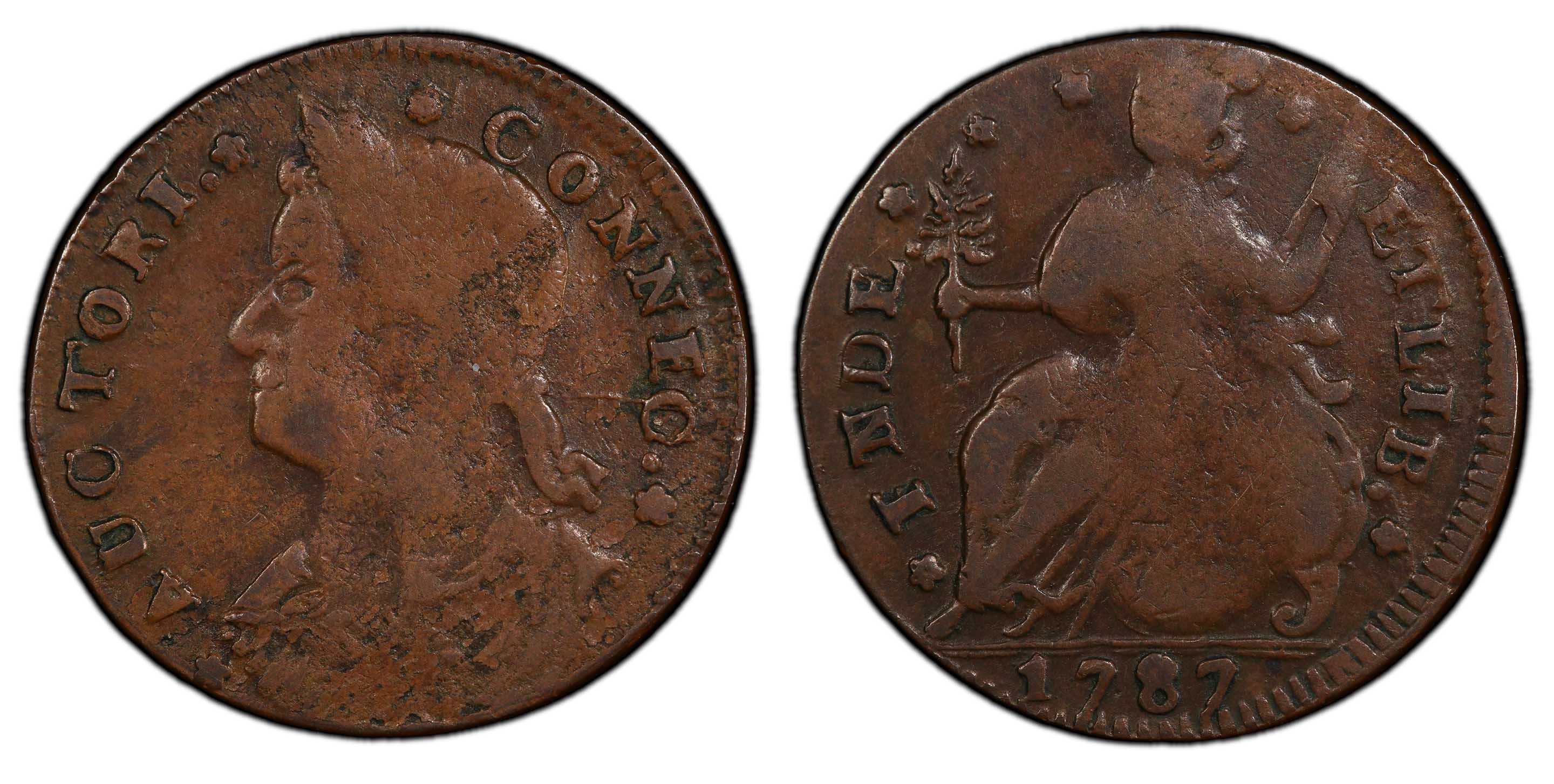
By May 14, 1787, the feds delivered 71,145 lbs. of copper to Jarvis & Co., formerly known as the Company for Coining Coppers.
James Jarvis had need for 10x that amount, so he left for Europe in November of that year to find a source, leaving ersatz mint superintendent Samuel Broome in charge.
The former company had a contract to mint Connecticut coppers, weighing 144 grains, and requiring 5% of the output be paid to the CT lege.
Fugio coppers on the other had were federally mandated to weigh 157.5 grains, and required 15% of the output to the feds.
So... in 1788 Broome crossed 24,284 lbs. from the "Fugio" side of the ledger to the "Connecticut" side of the ledger, and made Connecticut coppers with Fugio-earmarked copper.
Evidence of the crime was two-fold: the ledger itself, which still exists(!), and the coin above, a Miller 32.5-aa "FUDE" variety. Engraver Abel Buell used the same set of punches to produce Fugio and Connecticut dies (compare cinquefoils and odd shape of "F" in coins below), and apparently forgot which type he was making. He likely began punching the "FU..." of FUGIO at 8 o'clock on the reverse of a Connecticut die before realizing his mistake, and fixed it by punching "IN" of INDE ET LIB over the FU. The coin was backdated to 1787 to reflect the date of the older contract.
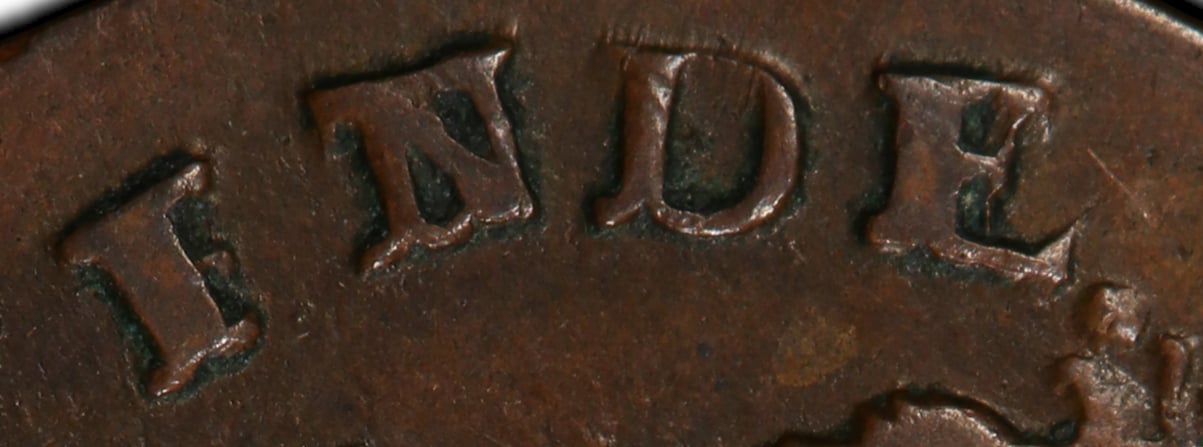
FANTASTIC reference for the above information:
McDowell, Christopher R. 2015. Abel Buell and the History of the Connecticut and Fugio Coinages. The Colonial Coin Collectors Club. 230p. I think I related it about right but would be pleased to hear any more about these scoundrels and if there is any more recent research on the FUDE type.
Upon reading the book I immediately began hunting for the above coin, thanks for the inspiration, Mr. McDowell.
So as to include a Fugio copper in a Fugio post, this is a Newman 21-I, one of my favorite varieties for the inexplicable "_" under the "SIN" portion of the best motto in American numismatics and the radical double die clashing, giving the sun-in-the-ring at 6 o'clock on the reverse the appearance of wearing double spectacles:
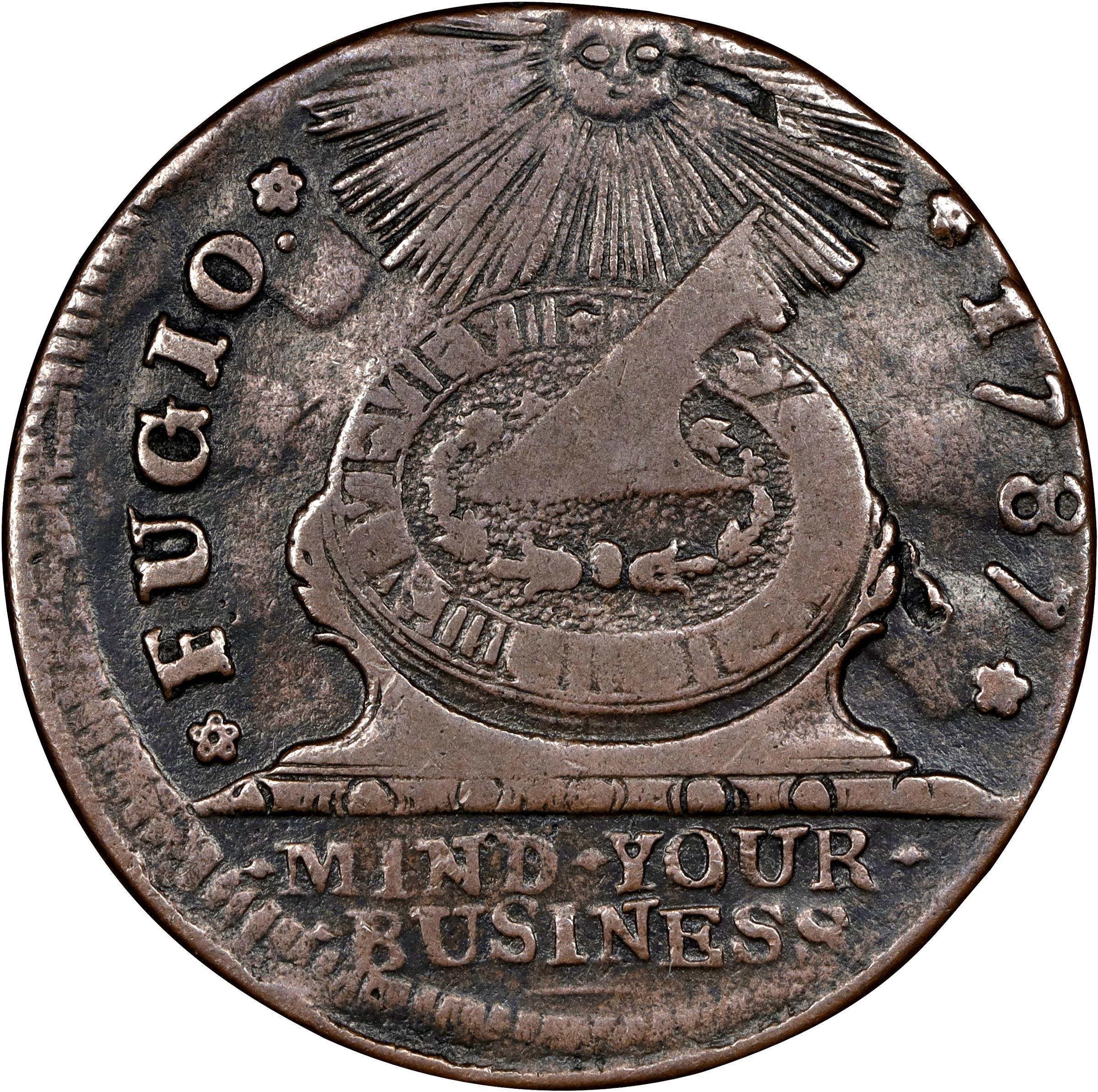
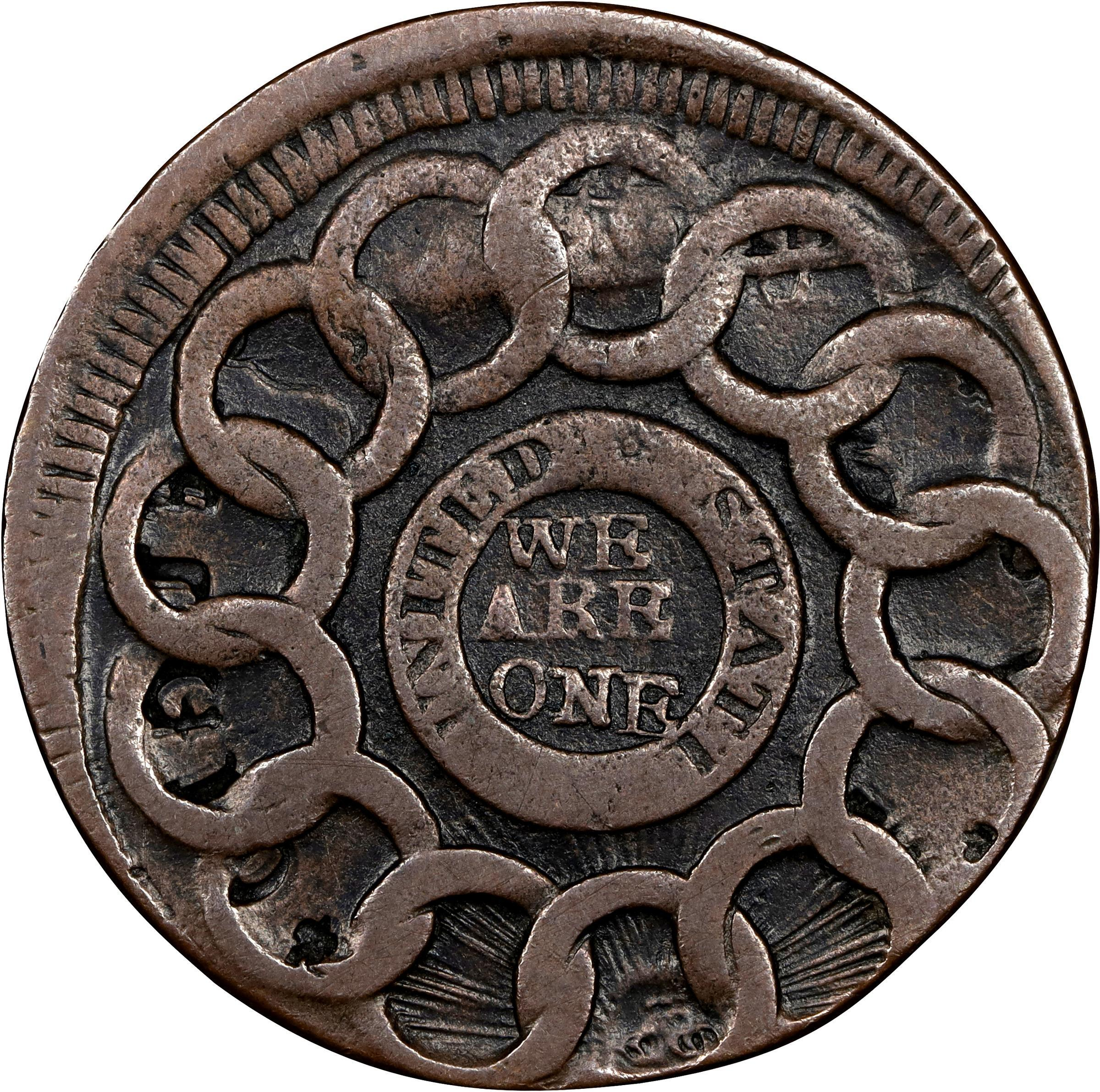
I don't "collect" these, but I have one as part of my appreciation of history. It lives in my (work in process) box of 20.
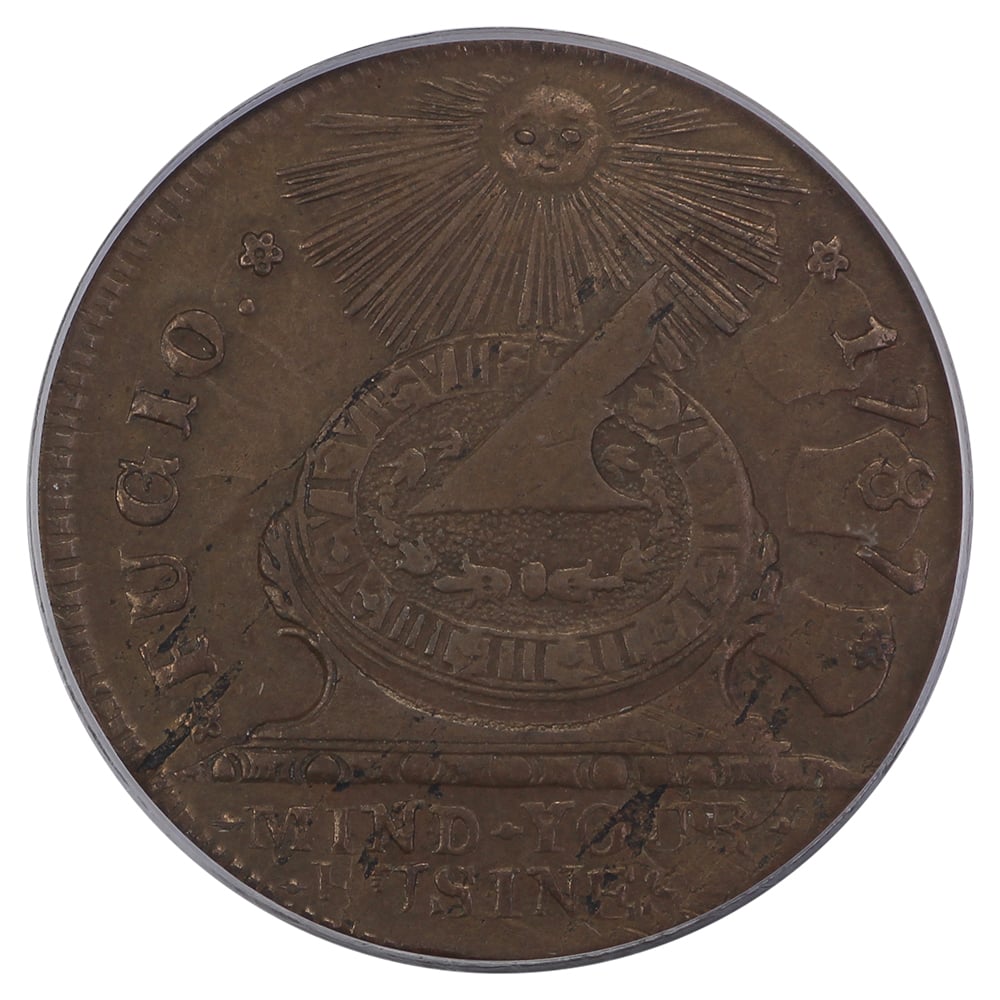
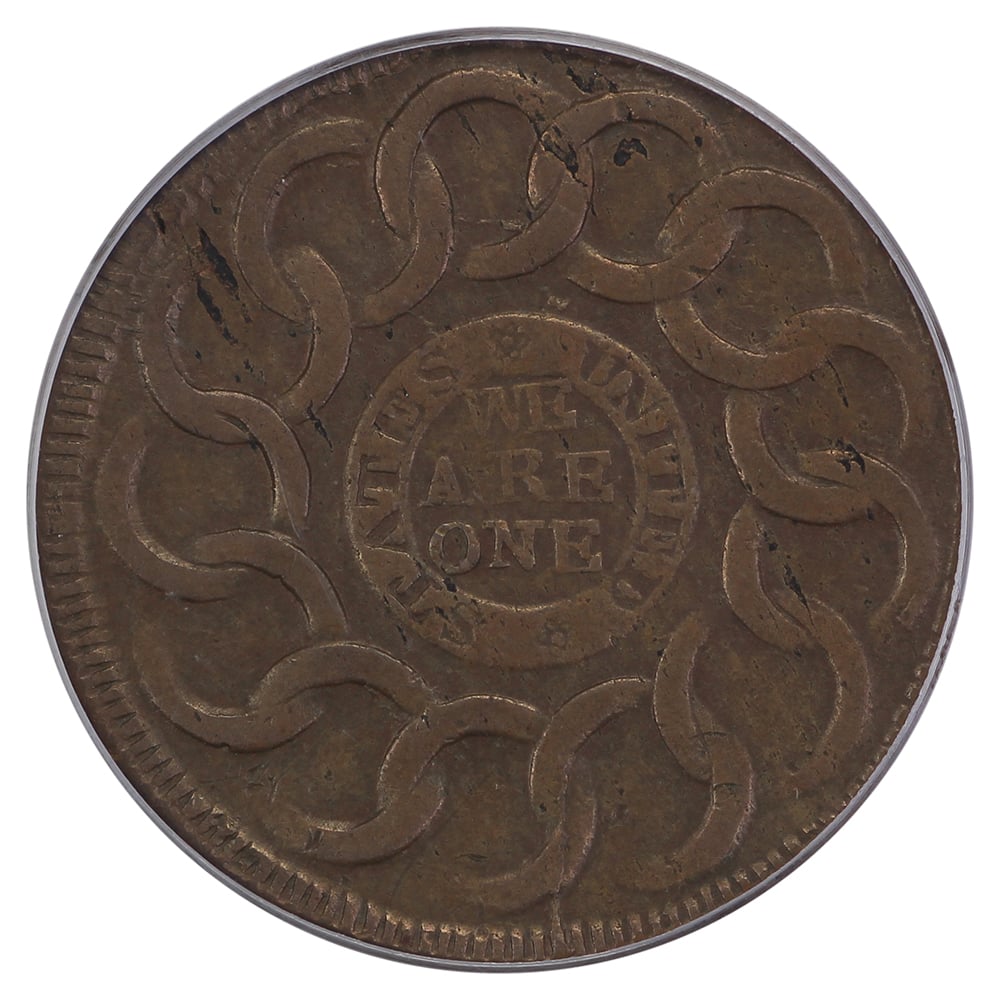
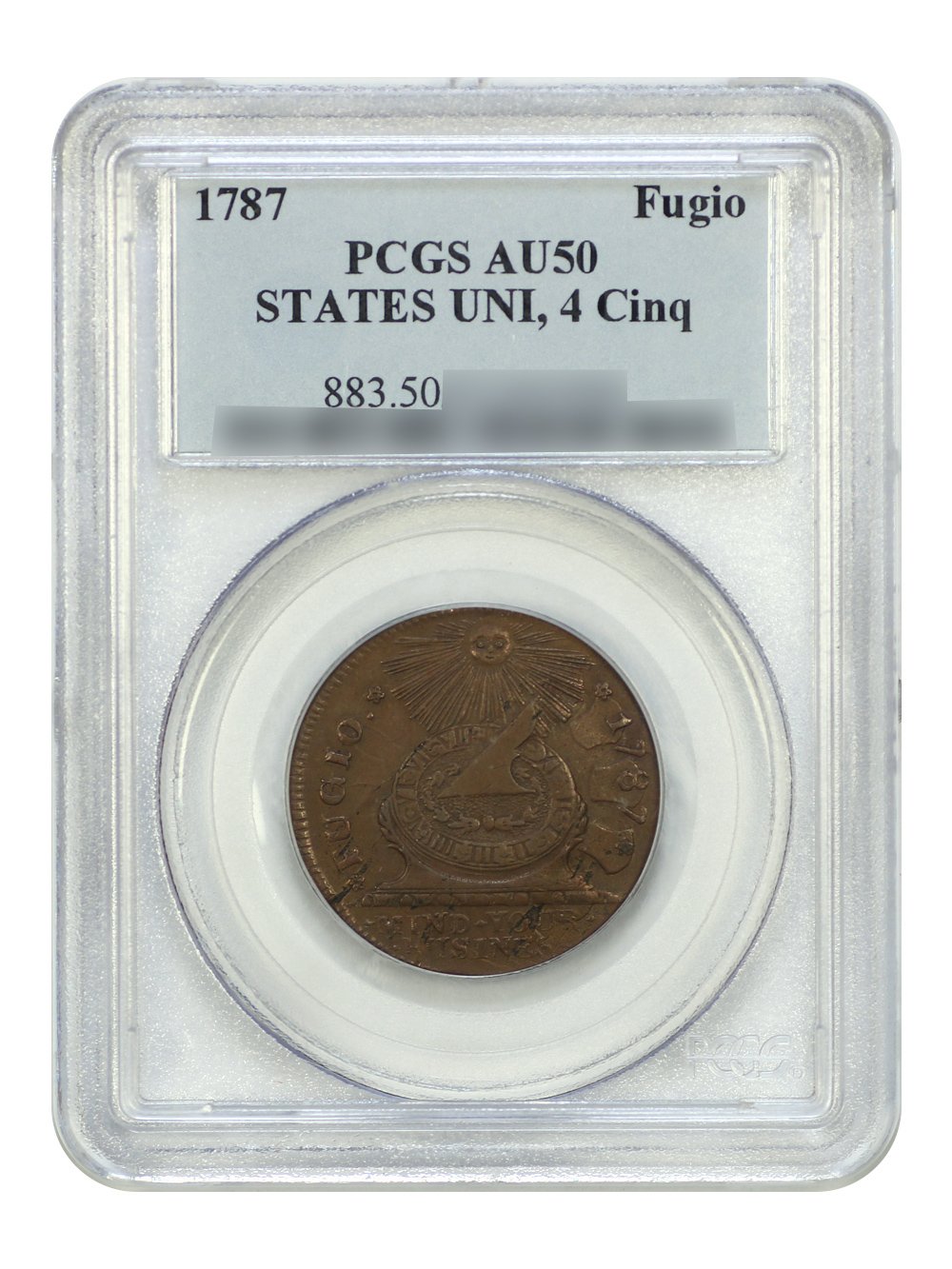
MLC's Newman 2-C (Club Rays, FUCIO) is an amazing coin. 2-C is a solid R6 and while there are a few XF pieces, most are VF and below and several are Details graded. Nice coin, if you ever wanna sell it....
@Rittenhouse - Thanks!
I have a couple, lower grades. One has a green bean, haven't sent in the other one yet.
I'm BACK!!! Used to be Billet7 on the old forum.
I used to own this one, it was framed with a story about the coin being part of the NY Bank hoard.
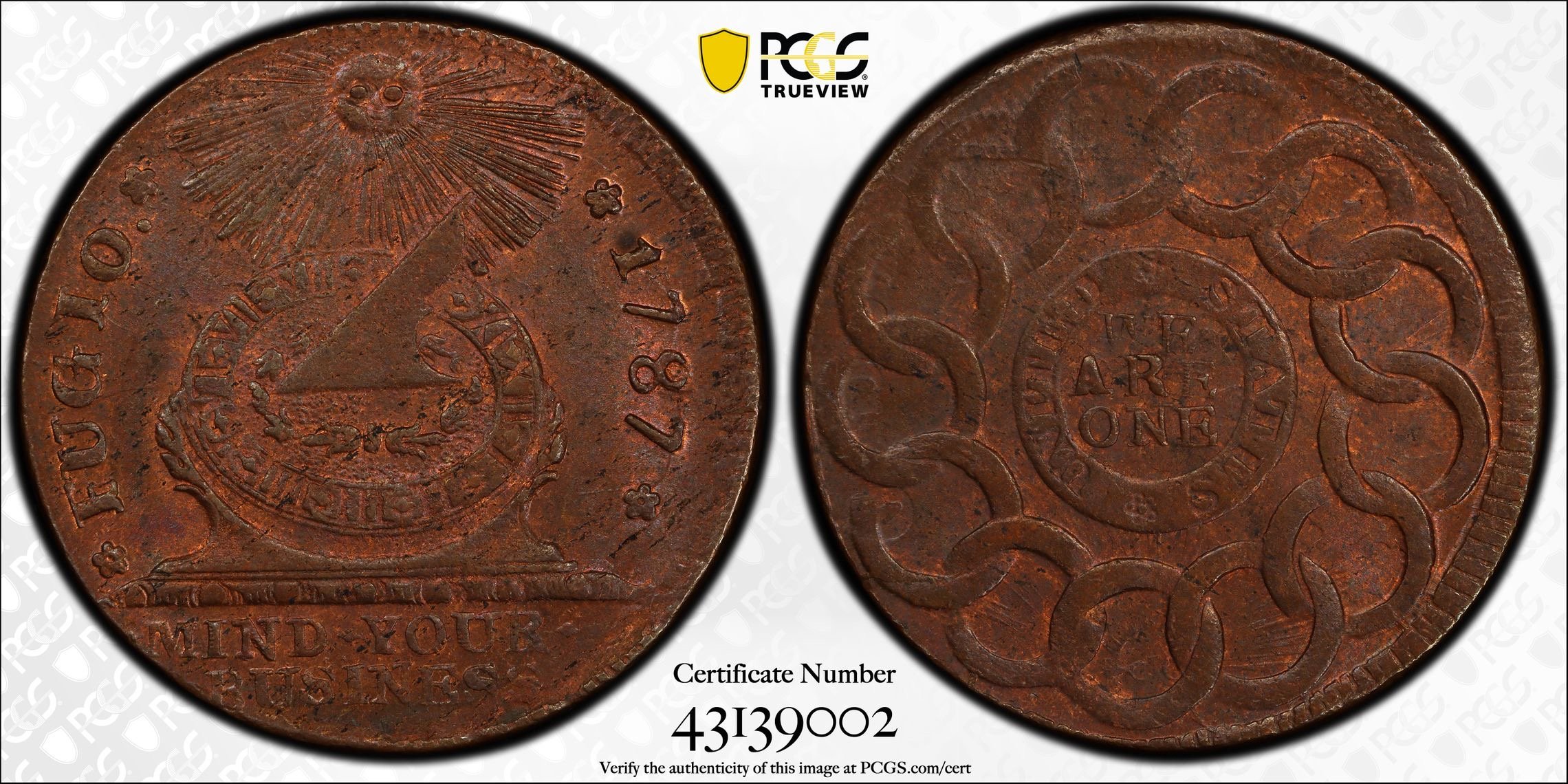
PCGS graded it 64BN, looks like someone sent it in for reconsideration and got it bumped to 65!
Also waiting for someone to chime in here and call them Fugio Pennies….😂
Love the P01. Like I said of MLC's 2-C, if you ever wanna sell it....
Awesome thread!!!
I bought one years ago. I've got to find it. I'd forgotten about it until reading this thread.
Is it know approximately how many coins were in the bank hoard?
Since I collect holed 8-)
I love this thread. Below is the Fugio in my collection. I thought about acquiring an MS example from the BNY hoard but quickly changed my mind. This was all about history to me and I wanted a nice example that perhaps was in Washington, Franklin or Jefferson's pocket . Although I have no intention to acquire other varieties I really treasure this coin.
. Although I have no intention to acquire other varieties I really treasure this coin.
Thank you Rittenhouse for enriching my day.
That's a great example! Congrats!
Are you saying the lower grade one I have is a 2-C?
I'm BACK!!! Used to be Billet7 on the old forum.
Great examples in here.
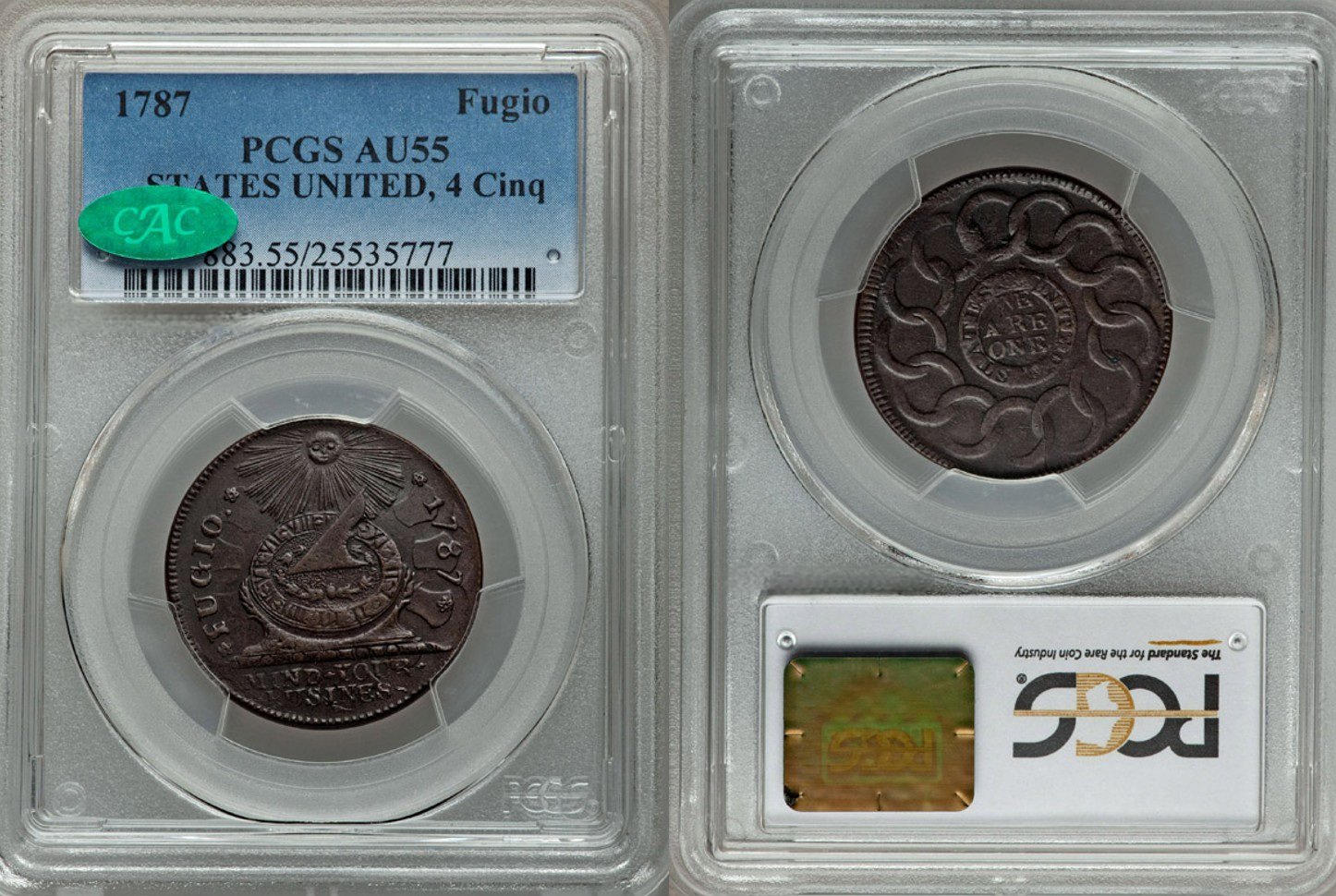
Any chance anyone here can please point me toward a copy of Fugio Copper Notes by Rob Retz? Thanks in advance if so...
I always liked this concise 2 page attribution guide by Dennis Rynes.
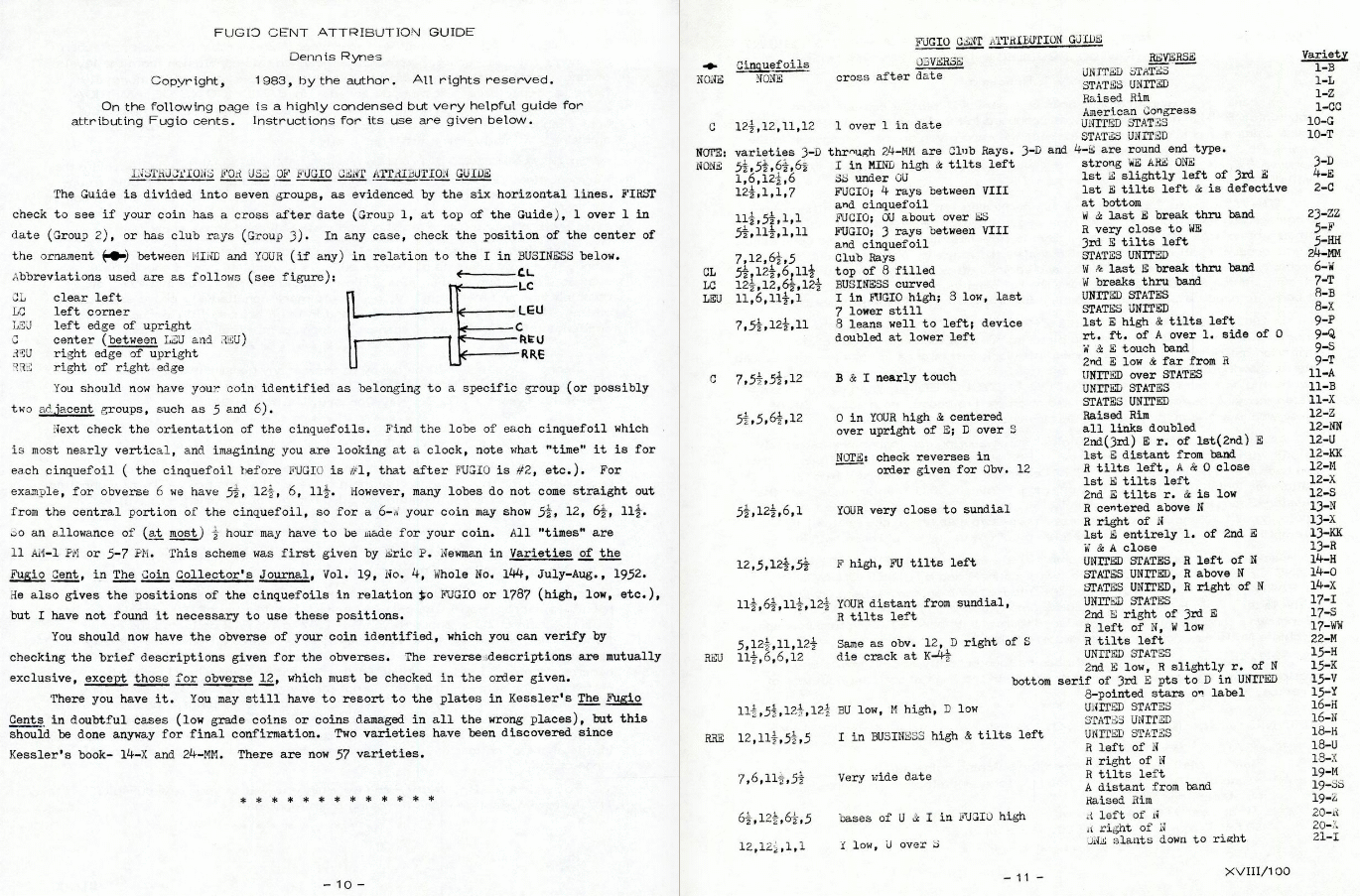
Is Dennis Rynes still alive? And/or, who currently owns copyright to his attribution guide?
Also, aren't there now 59 recognized Fugio die-marriages?
On the web: http://www.earlyus.com
I have this one as a placeholder until I find one that REALLY floats my boat.
Empty Nest Collection
I don't know if he is still alive. I checked and he would be age 81, so it's entirely possible he is alive.
The 2 page guide is from the EAC publication Penny-Wise vol. 18 no. 1, published January 15, 1984.
It is available on the Newman Numismatic Portal.
https://archive.org/details/pennywise18n1/page/n11/mode/2up?view=theater
So I believe that displaying it here with proper citation constitutes fair use.
I checked and it may be 61 now.
I found a 2017 version of the original coinfacts.com Fugio page on archive.org.
https://web.archive.org/web/20170508102912/http://www.coinfacts.com:80/colonial_coins/fugio_cents/fugio_cents.htm
It has a nice list of 61 die pairs grouped by major obverse and reverse features.
It includes 4 die pairs that are not in Rynes' list:
17-T - marriage of known dies, "rumored to exist in a New York collection"
10-OO - unique, discovered in 1988. photos and auction record in PCGS CoinFacts.
17-H - marriage of known dies
25-PP - club rays with concave ends; it has plate photos for this
It also has 12-LL which is assume is the same as 12-NN in Rynes' list.
The current PCGS CoinFacts pages have great photos, but it does not have an index page which maps the Newman die pairs to its categories.
https://www.pcgs.com/coinfacts/category/federal-contract-coinage/fugio-cents/fugio-cents-1787/845
However, it will show the Newman die pairs if you drill down far enough.
For example the 1/1 is Newman obverse 10.
If we select
https://www.pcgs.com/coinfacts/coin/1787-fugio-1c-states-united-1-over-horiz-bn/886
and then click on "Show Related Coins and Varieties (22)" about halfway down the page,
it shows
Newman 10-T
Newman 10-OO - This was discovered in 1988 and is currently unique. It actually sold on August 25 for $90k.
@renomedphys I really like that coin! To me it shows that it was likely used in commerce/trade during the infancy of our country.
I’ve always liked that “dark chocolate fields/peanut butter devices” look on very early copper.
I updated Dennis Rynes' 1983 attribution table to add the 4 newer die pairs and sort it by the 15 PCGS Registry set types.
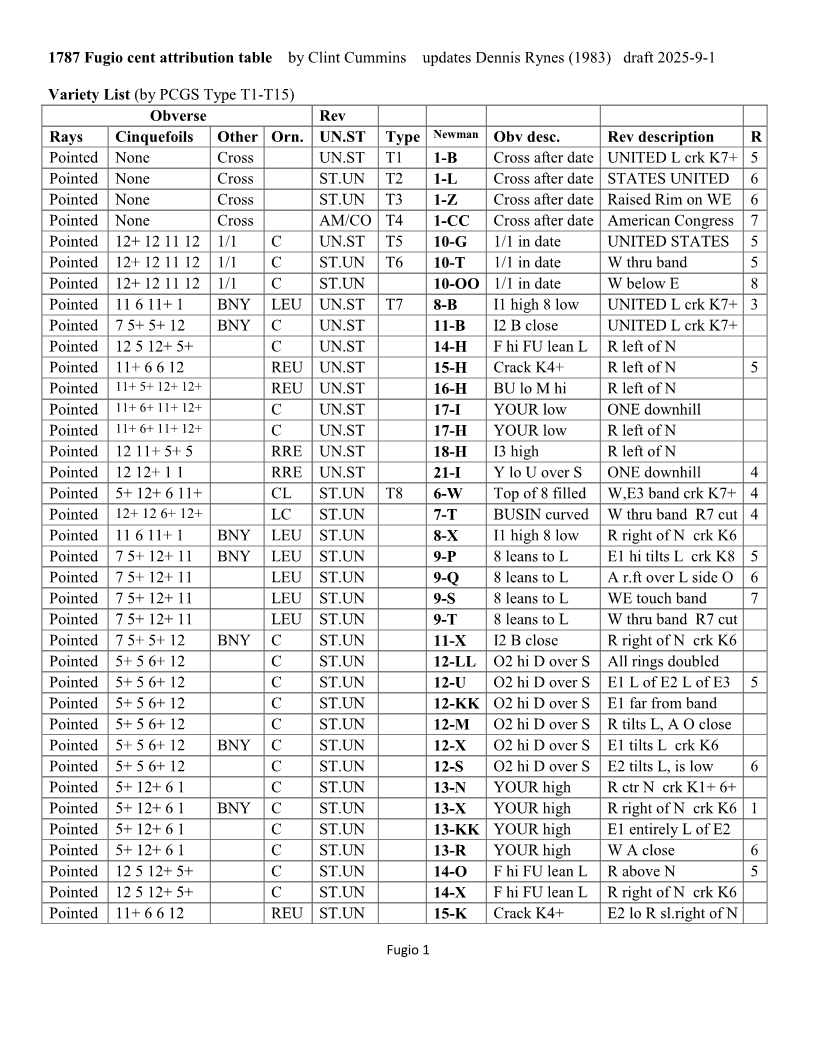
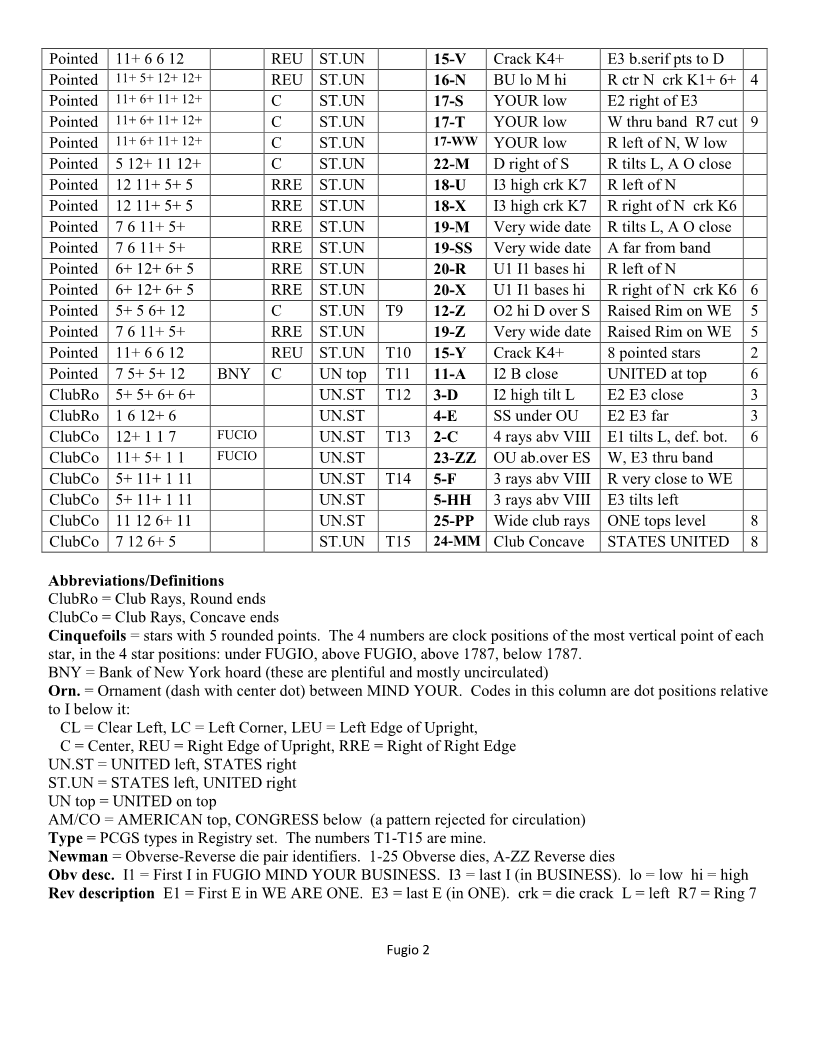
I left out the 4 "New Haven Restrike" items from the Registry set, since they are imitations.
@Rittenhouse noted that the AMERICAN CONGRESS type is really a rejected pattern, so perhaps I should have removed it as well.
Some rarity estimates from the old CoinFacts site and @Rittenhouse's posts are sprinkled in.
I was not able to fit all of Rynes' obverse and reverse descriptions in, so his document is helpful for those.
This may be usable for doing attributions without having to buy the $150 book.
But there may be better PDFs available for this. Conder101 mentions one on a different forum.
[Update 8/30 - added more die crack info, as these often help, improved Club Rays 3-D vs. 4-E.]
Thanks @Rittenhouse for the great thread. I’m picking up kernels of knowledge from the postings.
My coin activity dimmer switch has been on low for a bit, but browsing the forum lately, I’m pleased to see a renewed and climbing interest of the Fugio cent. In my opinion the most fantastic coin of them all. Not just the history and how they were made, but all the different looks they come in now. One of the main reasons I collect copper issues is they tend to all look different from piece to piece, way more fragile and subject to corrosion than I see in other metal types, adds a level of collecting difficulty.
Nevertheless, this is the one Fugio I possess. I was hunting around and poised to buy an example for a few good years before pulling the trigger on this one. I was targeting an MS coin with the most dramatic clashing I could find for the type. I’ve had it well over a decade and resides in my core collection, never get tired of it. These are really cool in person, if you’re on the fence just go for it.
@WildIdea can I be the first to say: DANG….
I'm BACK!!! Used to be Billet7 on the old forum.
This is a great thread with so much useful information about the beautiful Fugio cent series. .
.
Thank you, @Rittenhouse
I've collected Colonial and Early American coppers for a long time, and was excited to hear Fugio's are now considered the first federal large cent.
I bought these examples a long time ago, when they were still considered another in the series of pre-federal coppers.
wow... that's a pretty nice "placeholder" as Fugios go. Much better details and less damage than the ones I've been looking at (for over a year!)... but then, I'm limiting myself to $1500-2k for this hole in my Box of 20... :-/
Successful BST transactions with: SilverEagles92; Ahrensdad; Smitty; GregHansen; Lablade; Mercury10c; copperflopper; whatsup; KISHU1; scrapman1077, crispy, canadanz, smallchange, robkool, Mission16, ranshdow, ibzman350, Fallguy, Collectorcoins, SurfinxHI, jwitten, Walkerguy21D, dsessom.
These are nice ones.
I am testing my "attribution table", after adding more die crack info to it.
It seems to be working, though if I have any of these wrong, I'd be happy to hear about it.
14-O STATES UNITED and Ornament C narrowed this down a fair bit.
16-N The reverse die cracks are a quick way to ID this one.
15-H The obverse die crack and UNITED STATES ID this.